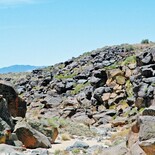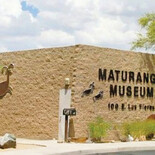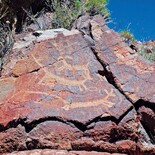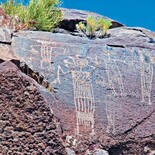The Coso Range: the Sistine Chapel of ancient rock art
Land of Four Seasons
June 24, 2023
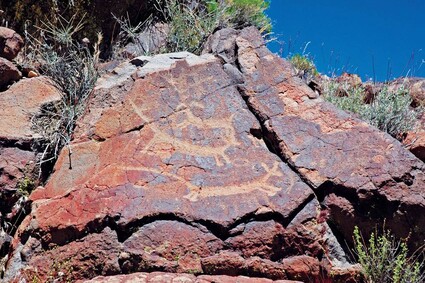
Jon Hammond.
Bighorn Sheep are among the most common symbols etched into the dark basalt rocks, but there are other animals as well.
When you hear the name of the Kern County city of Ridgecrest, do you immediately think to yourself: "Ah, that's near all the rock art." No? Well maybe you should, because the nearby Naval Air Weapons Station, China Lake is home to the Coso Rock Art District, the largest concentration of prehistoric petroglyphs in all of the Northern Hemisphere.
There are an incredible 100,000 individual rock carvings or more etched into the dark basalt boulders of the Coso Range, some of them believed to be more than 10,000 years old. In the past, tours have been offered through Ridgecrest's excellent Maturango Museum, and you could explore the ancient canyon of an extinct river, a sandy dry wash whose canyon walls are adorned with an unbelievable amount of rock art.
The Maturango Museum has been properly funded and is a fine museum, one of the best in this part of California. They have both depictions and exact replicas of many Coso petroglyphs, as well as a sculpture and native plant garden.
The Coso Range rock art has been well-preserved and protected against vandalism for one simple reason: it is located about an hour's drive inside the Naval Air Weapons Station, China Lake. This vast military base is the Navy's largest single landholding, covering 1.1 million acres, or nearly 20,000 square miles, that sprawl over three counties: Kern, San Bernardino and Inyo.
When you drive deep within the Mojave Desert lands of the NAWS China Lake, at 5,000 feet elevation, you come to a canyon of basalt rocks whose surfaces contain literally tens of thousands of petroglyphs. These are symbols that have been pecked or chipped into the rocks – "glyph" means "carving" – as opposed to pictographs, which are painted on the surface using pigments.
In the Coso Range, ancient peoples used hammer stones to chip away the dark patina or "desert varnish" on the surface of the volcanic basalt rocks, creating patterns and designs on the dark rock by exposing the lighter surfaces beneath. A great many of these symbols represent Desert Bighorn Sheep, which were one of the most prized game animals hunted by the Coso people. It is speculated that many of these sheep motifs were part of rituals intended to improve hunting success. The canyons containing a majority of the petroglyphs were formerly called Little and Big Petroglyph Canyons, but now they are often referred to as Upper and Lower Renegade Canyons.
In addition to the many depictions of bighorns, there are assorted hunting scenes, anthropoid figures, and many different geometric patterns. While there can be no certain explanation for the designs of artists who have been dead for hundreds or thousands of years, rock art scholars have come up with some credible explanations.
One of the world's leading experts on rock art, particularly that of the Coso Range, is highly respected archeologist and author David S. Whitley, who lives in Tehachapi and has written numerous books about rock art and its implication and motivations. David is giving a presentation sponsored by Tomo Kahni State Historic Park at Friendship Hall, 100 E. E St. on Saturday, June 24 at 10 a.m.
There is also a documentary film called Talking Stone, the Rock Art of the Cosos, by archeologist Alan Garfinkel Gold and filmmaker Paul Goldsmith, whose premiere was held in 2014 at the Hitching Posts Theaters in Tehachapi. This film is available at the Tehachapi Museum gift shop.
Tours to visit Renegade Canyon at China Lake to view this incredible rock art site were suspended during the pandemic, and unfortunately have not yet been resumed. Normally there are guided tours conducted in spring and fall, and it almost feels like time travel to be down in the canyon, discovering some of the thousands of ancient petroglyphs that adorn the desert rocks.
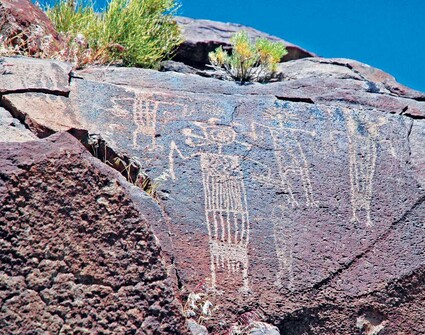
Jon Hammond.
Lower Renegade Canyon on the Naval Air Weapons Station, China Lake, is home to a remarkable assortment of rock art.
The Los Angeles Times included Renegade Canyon on a list of the top 15 sites in California to visit, and with ample justification: this astounding concentration of rock art is unparalleled in North America. I hope that the Navy will soon resume tours, and when they do, I encourage you to visit. Visiting the Coso Rock Art District should be a bucket list item for people who are interested in history and culture.
Keep enjoying the beauty of life in the Tehachapi Mountains.
Jon Hammond is a fourth generation Kern County resident who has photographed and written about the Tehachapi Mountains for 38 years. He lives on a farm his family started in 1921, and is a speaker of Nuwä, the Tehachapi Indian language. He can be reached at tehachapimtnlover@gmail.com.


